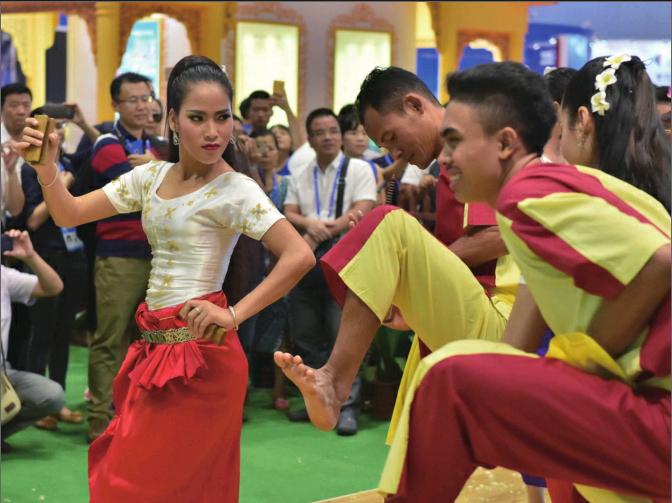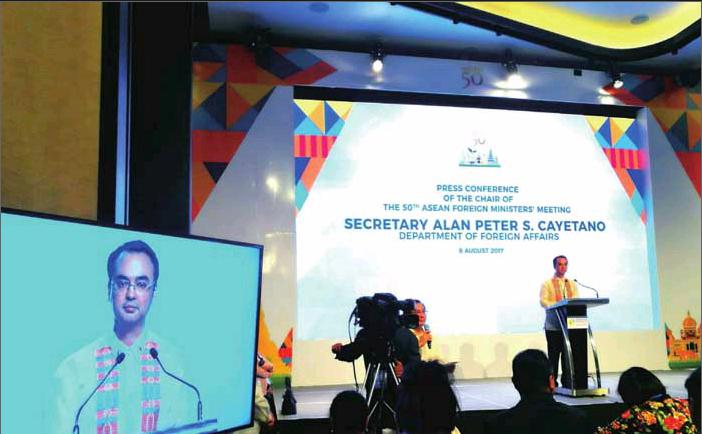Pacifying the Sea
2017-09-07ByYuLintao
By+Yu+Lintao


With the joint effort of China and member states of the Association of Southeast Asian Nations (ASEAN), foreign ministers of the 11 countries endorsed the framework of the Code of Conduct (COC) in the South China Sea at their meeting in Manila, the Philippines, on August 5, announcing that they would initiate substantive consultations on the text of the COC at a proper time within the year.
The latest progress marks an important step toward peaceful settlement of the maritime disputes concerning the South China Sea, which will also lay a good foundation for ChinaASEAN pragmatic cooperation.
Common will
Actually, the consensus on the COC framework was first reached at the 14th China-ASEAN Senior Officials Meeting on the implementation of the Declaration on the Conduct of the Parties in the South China Sea, which was held in Guiyang, capital of southwest Chinas Guizhou Province, in May. This time, the consensus was reconfi rmed by the foreign ministers meeting.
In a joint communiqué released on August 5 after the 50th ASEAN Foreign MinistersMeeting in Manila, participants showed they warmly welcome the improving cooperation between ASEAN and China and stated that they are encouraged by the conclusion and adoption of the COC framework, which they believe will facilitate the work for the conclusion of an effective COC on a mutually-agreed timeline.
Peace and stability in the South China Sea is the common will of the whole region. The calming down of the maritime disputes in the second half of 2016 happened through the joint efforts of China and ASEAN countries. And, more and more ASEAN countries are inclined to the view that peace in the South China Sea should be safeguarded jointly by regional countries, said Lou Chunhao, a researcher on maritime issues with the China Institutes of Contemporary International Relations (CICIR).
“We welcome the adoption of the COC framework, because it will meet the aspirations of people from ASEAN countries and China,”said Nguyen Thien Chi, a scholar from Ho Chi Minh City-based Viet Nam-China Friendship Association, in an interview with Chinas Xinhua News Agency.
Wilfrido Villacorta, former Philippine ambassador and permanent representative to ASEAN, told Xinhua that the framework, when translated into an actual COC, would defi nitely be a monumental joint contribution by ASEAN and China to peace and stability in the region.
The framework, which will shape consultations for the COC, envisions the COC to be a rules-based framework containing a set of norms to guide parties in the South China Sea and promote their maritime cooperation, Villacorta added.

Following the approval of the COC framework, Chinese Foreign Minister Wang Yi told reporters that the latest achievements on the South China Sea issue testify to the fact that China and ASEAN have the wisdom and capability to properly manage the disputes, formulate a set of regional rules that recognized by all, and preserve peace and stability in the South China Sea.
“We also hope that the two wheels of the COC consultations and maritime practical cooperation can run in parallel and reinforce each other,” Wang added.
Worries and hope
Despite regional countries having decided to settle the South China Sea issue themselves and the situation now developing on a positive track, some countries outside the region, namely the United States, Japan and Australia, are seemingly not quite happy about the positive move toward the peaceful settlement of the South China Sea maritime disputes. Shortly after the COC framework was endorsed, the three countries called on China and the Philippines in their joint statement to abide by the award of an arbitral tribunal in July 2016 in the arbitration case between the Philippines and China over the South China Sea.
The arbitration was unilaterally initiated by the Philippines Aquino III administration in 2013 but was boycotted by China, as the Chinese Government made a declaration in 2006, pursuant to Article 298 of the United Nations Convention on the Law of the Sea, excluding disputes regarding matters such as those related to maritime delimitation and historic titles from compulsory dispute settlement procedures including arbitration. Current Philippine President, Rodrigo Duterte, decided to put aside the arbitration award and turned to talks with China for the settlement of bilateral maritime disputes.
In response to the call of the three countries, Philippine Foreign Affairs Secretary Alan Peter Cayetano said at a press conference in Manila on August 8, “We are a sovereign nation. We will decide what is good for us and what strategy is good for us… We respect their views, but the problem of a territorial dispute between China and the Philippines is between China and the Philippines.”
On August 10, U.S. Navy destroyer USS John S. McCain conducted a so-called “freedom of navigation operation” in the South China Sea, coming within 12 nautical miles of Chinas Meiji Reef in a provocative fashion.
Lou of the CICIR pointed out that countries including the United States and Japan still dream to use the South China Sea issue as a means to contain China. “It cannot be ruled out that they will continue to play a damaging and negative role over the issue,” he said.
